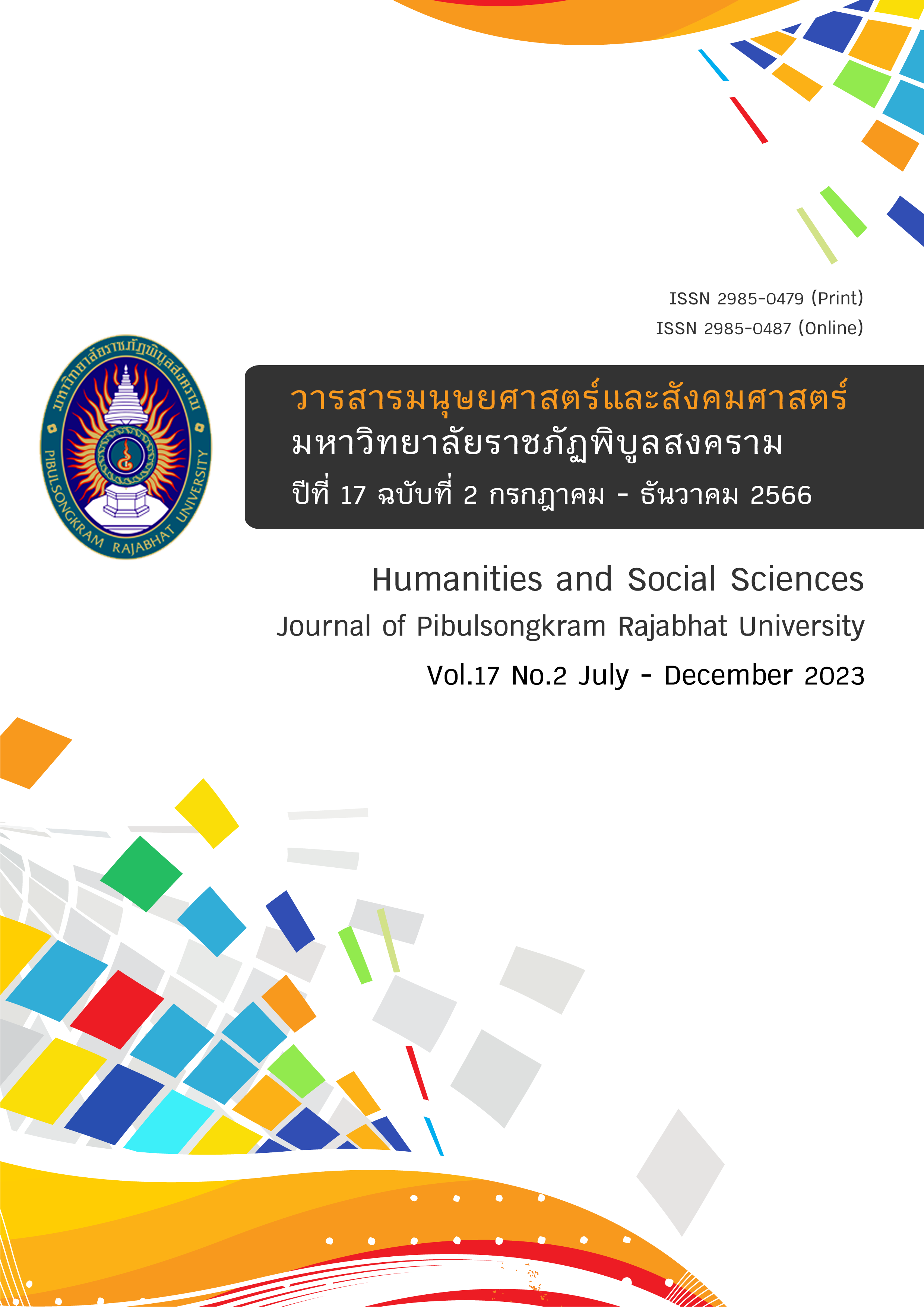A Comparative Study and Development of Norm Biological Literacy of Students of Princess Chulabhorn Science High Schools in Thailand
DOI:
https://doi.org/10.14456/psruhss.2023.50Keywords:
Norms, Biological literacy, Biology teachingAbstract
The normalization of biological literacy will determine the level of biological literacy competence in the population. The objective of this research is to develop the biological literacy of students of Princess Chulabhorn Science High Schools in Thailand. There are 1580 students of Princess Chulabhorn Science High Schools in Mathayom 6. The samples consist of 402 students selected by convenience sampling. The data was statistically analyzed by using basic statistics t-test one – way ANOVA T-score percentile and construct norms of biological literacy. The results of the study showed that when classified by gender, it was found that the mean of biological cognition in attitudes and in overall has statistically significant differences at the .05 level. The overall average scores of biological literacy were classified by each region does not have statistically significant differences. The sample of biological literacy norms were ranged from T20 to T80 (P0.12 – P99.88). The developed norms were based on norm-referenced evaluation of students of Princess Chulabhorn Science High Schools in Thailand. However, this research should be developed for other groups for applying the tools to assess students inclusively.
References
โครงการ PISA ประเทศไทย. (2560). กรอบโครงสร้างการประเมินผลนักเรียนโครงการ PISA 2015. สืบค้น 16 มีนาคม 2564, จาก https://library.ipst.ac.th/bitstream/handle/ipst/5534/32.PISA-2015-Framwrok.pdf?sequence=1&isAllowed=y.
นิธิรัตน์ อาโยวงษ์, และวิมล สำราญวานิช. (2554). การรู้วิทยาศาสตร์ของนักเรียนชั้นมัธยมศึกษาปีที่ 6 เรื่อง พันธุศาสตร์และเทคโนโลยีทางดีเอ็นเอ โดยการจัดกิจกรรมการเรียนรู้ตามแนวคิดวิทยาศาสตร์ เทคโนโลยี และสังคม ของ Yuenyong (2006). วารสารศึกษาศาสตร์, 5(4), 21-28.
บุญชม ศรีสะอาด. (2561). ทฤษฎีการวัดและการทดสอบ. สืบค้น 16 มีนาคม 2564, จาก http://watpon.in.th/thai/mod/page/view.php?id=6.
ประคอง ตังประพฤทธิ์กุล. (2558). ชีววิทยาคืออะไร. สืบค้น 14 มีนาคม 2564, จากhttps://www.youtube.com/watch?v=VEg_OuuI-F4.
พัชราภรณ์ พัฒนพงศ์, วรรณะ บรรจง, และอภิชาติ พัฒนวิริยะพิศาล. (2557). การสร้างแบบทดสอบวัดทักษะกระบวนการทางวิทยาศาสตร์สำหรับนักเรียนชั้นมัธยมศึกษาปีที่ 3. สืบค้น 25 สิงหาคม 2564, จาก http://www.hu.ac.th/Conference/conference2014/proceedings/data/3509/3509-5.pdf.
ศูนย์ดำเนินงาน PISA แห่งชาติ สถาบันส่งเสริมการสอนวิทยาศาสตร์และเทคโนโลยี. (2564). ผลการประเมิน PISA 2018 การอ่าน คณิตศาสตร์ และวิทยาศาสตร์. สืบค้น 29 สิงหาคม 2564, จาก https://pisathailand.ipst.ac.th/pisa2018-fullreport/.
สถาบันส่งเสริมการสอนวิทยาศาสตร์และเทคโนโลยี กระทรวงศึกษาธิการ. (2561). เทคโนโลยีทางดีเอ็นเอ. กรุงเทพฯ: โรงพิมพ์แห่งจุฬาลงกรณ์มหาวิทยาลัย.
สำนักงานคณะกรรมการการศึกษาขั้นพื้นฐาน กระทรวงศึกษาธิการ. (2560). ตัวชี้วัดและสาระการเรียนรู้แกนกลาง กลุ่มสาระการเรียนรู้วิทยาศาสตร์ (ฉบับปรับปรุง พ.ศ. 2560). สืบค้น 14 มีนาคม 2564, จาก http://physics.ipst.ac.th/wp-content/uploads/sites/2/2019/02/SciCurriculum_2560.pdf.
สำนักบริหารงานความเป็นเลิศด้านวิทยาศาสตร์ศึกษา. (2562). แผนกลยุทธ์กลุ่มโรงเรียนวิทยาศาสตร์จุฬาภรณราชวิทยาลัย. https://www.pcccr.ac.th/filesAttach/OIT/O4/1.pdf
สุไรละ บิลตะเย็บ, สธน เสนาสวัสดิ์, และทัศนีย์ ประธาน. (2558). การสร้างแบบทดสอบทักษะกระบวนการทางวิทยาศาสตร์ สำหรับนักเรียนชั้นมัธยมศึกษาปี ที่ 3 โรงเรียนเอกชนสอนศาสนาอิสลามในจังหวัดสงขลา. วารสารวิจัยบัณฑิตศึกษา, 8(1), 90-107.
อามีล มาหามะ, อาฟีฟี ลาเต๊ะ, และแววฤดี แววทองรักษ์. (2564). การศึกษาเปรียบเทียบและการสร้างเกณฑ์ปกติการรู้วิทยาศาสตร์ของนักศึกษาวิชาชีพครูในพื้นที่สามจังหวัดชายแดนภาคใต้. วารสารมหาวิทยาลัยราชภัฏยะลา, 16(3), 287-296.
Clark-Carter, D. (2005). Percentiles. In Everitt, B. S. & Howell, D. C. (eds.), Encyclopedia of Statistics in Behavioral Science. Chichester, UK: Wiley & Sons.
Krejcie, R. V., & Morgan, D. W. (1970). Determining sample size for research activities. Educational and psychological measurement, 30(3), 607-610.
Lynn, M. R. (1986). Determination and quantification of content validity. Nursing Research, 35, 382-385.
Onel, A., & Durdukoca, S.F. (2019). Identifying the Predictive Power of Biological Literacy and Attitudes Toward Biology in Academic Achievement in High School Students. International Online Journal of Educational Sciences, 11(2), 214-228.
Organisation for Economic Co-operation and Development (2016). Organisation for Economic Co-operation and Development. Retrieved August 29, 2021, from http://www.internationalinnovation.com/build/wp-content/uploads/2014/08/OECD_Intl_Innovation_150_Research_Media.pdf
Suwono, H., Pratiwi, H., E., Susanto, H., & Susilo, H. (2017). Enhancement of Students’ Biological Literacy and Critical thinking of Biology Through Socio-Biological Case-Based Learning. Pendidikan IPA Indonesia, 6 (2), 213-220.
Thomson, S., Hillman, K., & Bortoli, L. D. (2013). A teacher’s guide to PISA scientific literacy. Victoria, Australia: ACER Press.
Downloads
Published
How to Cite
Issue
Section
License
Copyright (c) 2023 Humanities and Social Sciences Journal of Pibulsongkram Rajabhat University

This work is licensed under a Creative Commons Attribution-NonCommercial-NoDerivatives 4.0 International License.
Any articles or comments appearing in the Journal of Humanities and Social Sciences, Rajabhat Phibulsongkram University, are the intellectual property of the authors, and do not necessarily reflect the views of the editorial board. Published articles are copyrighted by the Journal of Humanities and Social Sciences, Rajabhat Phibulsongkram University.









